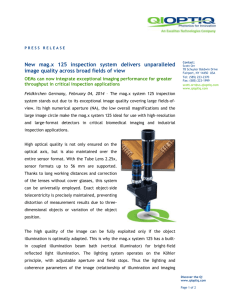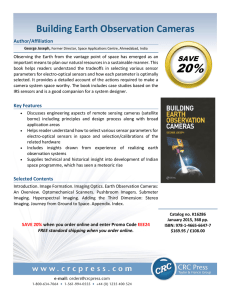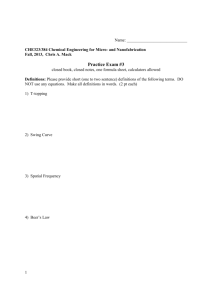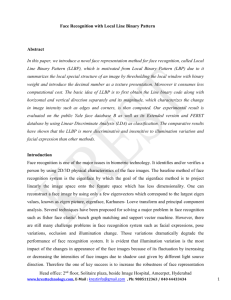Diffuse imaging: Replacing lenses and mirrors with omnitemporal cameras Please share
advertisement
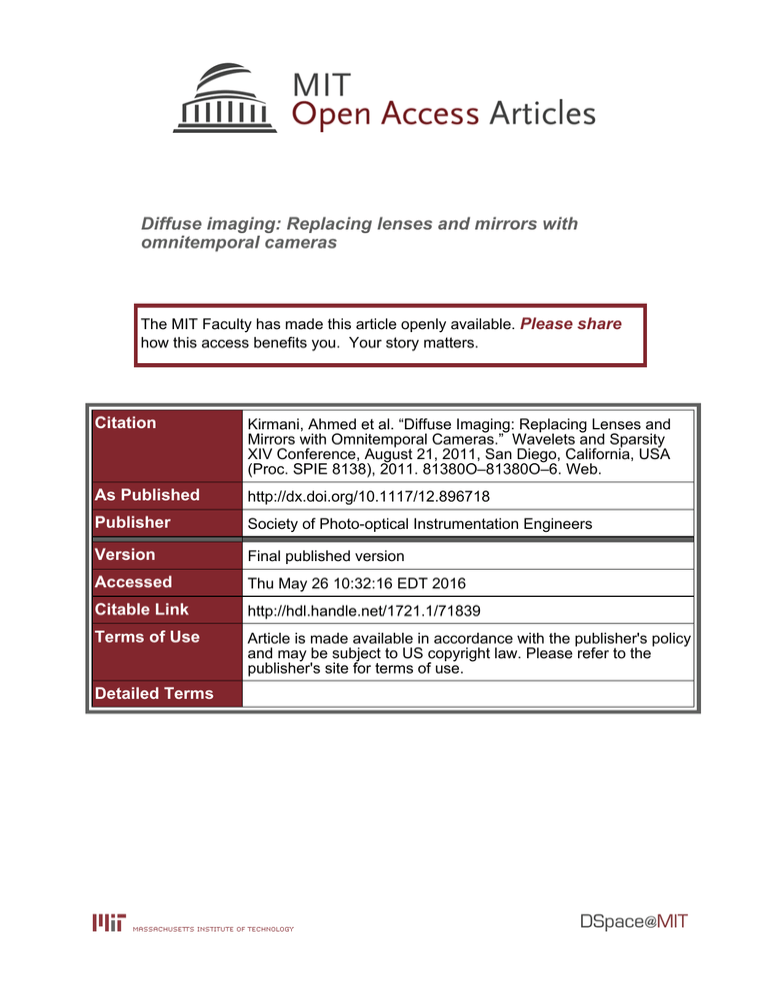
Diffuse imaging: Replacing lenses and mirrors with
omnitemporal cameras
The MIT Faculty has made this article openly available. Please share
how this access benefits you. Your story matters.
Citation
Kirmani, Ahmed et al. “Diffuse Imaging: Replacing Lenses and
Mirrors with Omnitemporal Cameras.” Wavelets and Sparsity
XIV Conference, August 21, 2011, San Diego, California, USA
(Proc. SPIE 8138), 2011. 81380O–81380O–6. Web.
As Published
http://dx.doi.org/10.1117/12.896718
Publisher
Society of Photo-optical Instrumentation Engineers
Version
Final published version
Accessed
Thu May 26 10:32:16 EDT 2016
Citable Link
http://hdl.handle.net/1721.1/71839
Terms of Use
Article is made available in accordance with the publisher's policy
and may be subject to US copyright law. Please refer to the
publisher's site for terms of use.
Detailed Terms
Diffuse imaging:
Replacing lenses and mirrors with omnitemporal cameras
Ahmed Kirmani,a Haris Jeelani, Vahid Montazerhodjat,a and Vivek K Goyala
a Massachusetts
Institute of Technology, Cambridge, MA 02139, USA
ABSTRACT
Conventional imaging uses steady-state illumination and light sensing with focusing optics; variations of the light
field with time are not exploited. We develop a signal processing framework for estimating the reflectance f of a
Lambertian planar surface in a known position using omnidirectional, time-varying illumination and unfocused,
time-resolved sensing in place of traditional optical elements such as lenses and mirrors. Our model associates
time sampling of the intensity of light incident at each sensor with a linear functional of f . The discrete-time
samples are processed to obtain 2 -regularized estimates of f . Using non-impulsive, bandlimited light sources
instead of impulsive illumination significantly improves signal-to-noise ratio (SNR) and reconstruction quality.
Keywords: light transport, optical imaging, reflectance, resolution, quantization, sampling, time of flight
1. INTRODUCTION
Imaging is distinguished from other forms of sensing by having the goal of producing an image—a representation
in one-to-one spatial correspondence with an object or scene. Traditional imaging involves illumination of the
scene with a light source whose intensity does not vary with time. The image, or the reflectance pattern on
scene surfaces, is acquired by using a lens to focus the reflected light on a two-dimensional (2D) array of light
meters. This paper expounds a diffuse imaging framework through which a focused image is produced without
optical focus; instead, the image is reconstructed from time-resolved measurements of light intensity in response
to time-varying scene illumination. Diffuse imaging opens up possibilities for forming images without lenses and
mirrors and enables practical implementations of challenging new applications such as imaging occluded scenes.1
The use of high-speed sensing in photography is associated with effectively stopping motion.2, 3 We use timeresolved sensing differently: to differentiate among paths of different lengths from light source to scene to sensor.
Thus, like in time-of-flight range measurement systems,4, 5 we are exploiting that the speed of light is finite.
However, rather than using the duration of delay to infer distances, we use temporal variation in the intensity of
measured light to infer scene reflectance. This is achieved through a computational unmixing of the reflectance
information that is linearly combined at the sensor because distinct optical paths may have equal path length.
Diffuse imaging involves only the use of diffuse or omnidirectional light sources and omnidirectional light
sensors. In conventional photography, the light source is omnidirectional but the sensor array is focused at
the scene. A dual configuration is also possible in which the sensing is omnidirectional and the light source
is directed, with optical focusing.6 Optical focusing enables imaging without the use of time, while in diffuse
imaging we create focus computationally by exploiting time variations in the incident light field.
The paper is organized as follows: Sections 2, 3, and 4 expand on earlier work of Kirmani et al.,1 especially by
providing a precise signal processing model. Sections 5 and Section 6 show how to improve upon the theoretical
and practical limitations of using impulsive illumination and ultrafast sensing as proposed in the earlier work.1
In particular, simulations suggest that diffuse imaging can be applied to build practical imaging systems using
non-ultrafast, opto-electronic hardware used in standard optical communication systems.
2. SCENE RESPONSE TO IMPULSIVE ILLUMINATION
Consider the imaging scenario depicted in Fig. 1, with a planar surface to be imaged, a single, time-varying,
monochromatic, omnidirectional illumination source, and omnidirectional time-resolved sensors indexed by k ∈
{1, 2, . . . , K}. We assume that the position, orientation, and dimensions (L-by-L) of the planar surface are
known. Estimation of these geometric parameters using diffuse illumination and time-resolved sensing was
Wavelets and Sparsity XIV, edited by Manos Papadakis, Dimitri Van De Ville, Vivek K. Goyal,
Proc. of SPIE Vol. 8138, 81380O · © 2011 SPIE · CCC code: 0277-786X/11/$18
doi: 10.1117/12.896718
Proc. of SPIE Vol. 8138 81380O-1
Downloaded from SPIE Digital Library on 10 Jul 2012 to 18.51.3.76. Terms of Use: http://spiedl.org/terms
Figure 1. An omnidirectional source (red point) illuminates a planar scene, and the reflected light is measured at a 4-by-4
array of sensors (blue points).
recently demonstrated.7 Formation of an ideal gray scale image is the recovery of the reflectance pattern on the
surface, which can be modeled as a 2D function f : [0, L]2 → [0, 1]. We assume the surface to be Lambertian so
that its perceived brightness is invariant to the angle of observation;8 incorporation of any known bidirectional
reflectance distribution function would not add insight.
The light incident at Sensor k is a combination of the time-delayed reflections from all points on the planar
surface. For any one point x = (x1 , x2 ) ∈ [0, L]2 , the contribution is delayed based on the total distance dk (x)
traveled by the light, and it is attenuated by both the reflectance f (x) and a geometric factor related to radial
fall-off and foreshortening.8 When the intensity of the omnidirectional illumination is a unit impulse at time 0,
denoted s(t) = δ(t), the contribution from point x is the light signal
ak (x) f (x) δ(t − dk (x))
for a known attenuation function ak (x), where we have normalized to unit speed of light.
Combining contributions over the plane, the total light incident at Sensor k is
gk (t) =
L
0
L
0
ak (x(s)) f (x) δ(t − dk (x)) dx1 dx2 .
(1)
Thus, evaluating gk (t) at a fixed t amounts to integrating over x ∈ R2 with dk (x) = t. Define the isochronal
curve
Ckt = {x : dk (x) = t}.
Then
gk (t) =
ak (x(s))f (x(k, s)) ds
(2)
where x(k, s) is a parameterization of Ckt with unit speed. The intensity gk (t) thus contains the contour integrals
over Ckt ’s of the desired function f . Each Ckt is a level curve of dk (x); these are ellipses.
3. SAMPLING THE SCENE RESPONSE
A digital system can use only samples of gk (t) rather than the continuous-time function itself. We now see how
uniform sampling of gk (t) with a linear time-invariant (LTI) prefilter relates to linear functional measurements
of f . This establishes the foundations of a Hilbert space view of diffuse imaging.
Suppose discrete samples are obtained at Sensor k with sampling prefilter hk (t) and sampling interval Tk :
yk [n] = gk (t) ∗ hk (t) t=nT ,
n = 1, 2, . . . , N.
(3)
k
Proc. of SPIE Vol. 8138 81380O-2
Downloaded from SPIE Digital Library on 10 Jul 2012 to 18.51.3.76. Terms of Use: http://spiedl.org/terms
A sample yk [n] can be seen as a standard L2 (R) inner product between gk and a time-reversed and shifted hk :9
yk [n] = gk (t), hk (nTk − t).
(4)
Using (1), we can express (4) in terms of f using the standard L2 ([0, L]2 ) inner product:
yk [n]
ϕk,n (x)
=
f, ϕk,n =
ak (x) hk (nTk − dk (x)).
where
(5a)
(5b)
Over a set of sensors and sample times, {ϕk,n } will span a subspace of L2 ([0, L]2 ), and a sensible goal is to form
a good approximation of f in that subspace.
4. IMAGE RECOVERY USING LINEAR BACKPROJECTION
To express an estimate fˆ of the reflectance f , it is convenient to fix an orthonormal basis for a subspace of
L2 ([0, L]2 ) and estimate the expansion coefficients in that basis. For an M -by-M pixel representation, let
⎧
⎨ M/L, for (i − 1)L/M ≤ x1 < iL/M ,
(j − 1)L/M ≤ x2 < jL/M ;
ψi,j (x) =
(6)
⎩
0, otherwise
so that
fˆ =
M
M ci,j ψi,j
i=1 j=1
in the span of {ψi,j } is constant on Δ-by-Δ patches, where Δ = L/M . We will form a system of linear equations
to find coefficients {ci,j }.
For fˆ to be consistent with the value measured by Sensor k at time n, we must have
yk [n] = fˆ, ϕk,n =
M
M ci,j ψi,j , ϕk,n .
(7)
i=1 j=1
Note that the inner products {ψi,j , ϕk,n } exclusively depend on Δ, the positions of illumination and sensors,
K
the plane geometry, the sampling prefilters {hk }K
k=1 , and the sampling intervals {Tk }k=1 —not on the unknown
reflectance of interest f . Hence, we have a system of linear equations to solve for the coefficients {ci,j }. (In the
case of basis (6), the coefficients are directly the pixel values.)
When we specialize to a box sensor impulse response and basis (6), many inner products ψi,j , ϕk,n are zero
so the linear system is sparse. The inner product ψi,j , ϕk,n is nonzero when reflection from the (i, j) pixel
affects the light intensity at Sensor k within time interval [(n − 1)T, nT ]. Thus, for a nonzero inner product the
(n−1)T
(i, j) pixel must intersect the elliptical annulus between Ck
and CknT . This occurs for a small number of
(i, j) pairs unless M is small or T is large. The value of a nonzero inner product depends on the fraction of the
square pixel that overlaps with the elliptical annulus and the attenuation factor ak (x).
To express (7) with a matrix multiplication, replace double indexes with single indexes (i.e., vectorize, or
reshape) as
y = Ac
(8)
where y ∈ RKN contains the data samples {yk [n]}, the first N from Sensor 1, the next N from Sensor 2, etc.; and
2
c ∈ RM contains the coefficients {ci,j }, varying i first and then j. Then ψi,j , ϕk,n appears in row (k − 1)N + n,
2
column (i − 1)M + j of A ∈ RKN ×M .
Assuming that A has a left inverse (i.e., rank(A) = M 2 ), one can form an image by solving (8). The portion
of A from one sensor cannot have full column rank because of the collapse of information along elliptical annuli.
Full rank can be achieved with an adequate number of sensors, noting that sensor positions must differ to increase
rank, and—as demonstrated in Section 6—greater distance between sensor positions improves conditioning.
Proc. of SPIE Vol. 8138 81380O-3
Downloaded from SPIE Digital Library on 10 Jul 2012 to 18.51.3.76. Terms of Use: http://spiedl.org/terms
ηk (t)
- gk (t)
s(t)
-⊕? - hk (t)
- rk (t)
Figure 2. Block diagram abstraction for signal sampled at Sensor k.
5. ILLUMINATION DESIGN
A Dirac impulse illumination is an abstraction that cannot be realized in practice. One can use expensive,
ultrafast optical lasers that achieve Terahertz bandwidth as an approximation to impulsive illumination, as
in experimental verification of our framework.1 We show that non-impulsive illuminations are not only more
practical for implementation, but they improve upon impulsive illumination for typical scenes and sensors.
Light transport is linear and time invariant. Hence, one can consider the effect of a general illumination
s(t) as the superposition of effects of constant illuminations over infinitesimal intervals. The light incident at
Sensor k is changed from (1) by a convolution with s(t). Thus, the block diagram in Fig. 2 represents the signal
at Sensor k, including its sampling prefilter and photodetector noise represented by ηk (t). Except at very low
flux, ηk (t) is modeled well as single-independent, zero-mean, white and Gaussian. The noise variance σ 2 depends
on the device physics and assembly; our simulations use σ = 0.1.
A typical natural scene f has a good bandlimited approximation. Integration over elliptical contours Ckt
further smooths the signal. Thus, s(t) is best chosen to be lowpass to put signal energy at frequencies most
present in gk (t).
6. SIMULATIONS
1
In earlier experimental work, high-bandwidth illumination and sampling were used under the assumption that
these would lead to higher reconstruction resolution. However, impulsive illumination severely limits the illumination energy, leading to poor SNR, especially due to the radial fall-off attenuations.
Here we compare impulsive and lowpass illumination. All image reconstructions are obtained with a modification of (8) using regularization by the 2 -norm of the Laplacian, a conventional technique for backprojection.10
The regularization is optimized for 2 error. Results are for M = 40 and several values of sampling period T and
sensor array extent W .
In direct analogy with the earlier experimental work,1 we simulated short-pulsed, high-bandwidth illumination
using a square wave source with unit amplitude and time width equal to one-fifth of T . Fig. 3 shows the results.
Reconstruction with good spatial resolution is indeed possible, and the conditioning improves as W increases
and as T decreases.
Using non-impulsive, low-bandwidth illumination, we show that high SNR can be achieved while improving
the reconstruction resolution. We chose s(t) to be the truncated impulse response of a third-order Butterworth
filter, with again a unit amplitude. This choice of s(t) produces a much stronger scene reflection and hence improves the SNR at the detector without any loss of matrix conditioning. Fig. 4 shows the resulting improvements
in reconstructed images. Hence, the choice of a non-impulsive illumination is not only practical but demonstrably
better in terms of image reconstruction quality.
7. SUMMARY
Earlier proof-of-concept experiments show that diffuse imaging can succeed in forming image reconstructions.1
In this paper we have used signal processing abstractions to show that using lowpass time-varying illumination
instead of impulsive sources improves the SNR and reconstruction quality. Our work inspires detailed study of
how pixel size, sensor locations, sampling prefilters, and sampling rates affect the conditioning of the inverse
problem.
Proc. of SPIE Vol. 8138 81380O-4
Downloaded from SPIE Digital Library on 10 Jul 2012 to 18.51.3.76. Terms of Use: http://spiedl.org/terms
W = 0.5
T = 0.5
T = 0.2
5
5
10
10
10
15
15
15
20
20
20
25
25
25
30
30
30
35
35
40
W = 2.0
5
10
15
20
25
30
35
40
40
35
5
10
15
20
25
30
35
40
40
5
5
5
10
10
10
15
15
15
20
20
20
25
25
25
30
30
30
35
35
40
5
W = 4.0
T = 0.05
5
10
15
20
25
30
35
40
40
10
15
20
25
30
35
40
40
5
5
10
10
10
15
15
15
20
20
20
25
25
25
30
30
30
35
35
5
10
15
20
25
30
35
40
40
10
15
20
25
30
35
40
5
10
15
20
25
30
35
40
5
10
15
20
25
30
35
40
35
5
5
40
5
35
5
10
15
20
25
30
35
40
40
Figure 3. Reconstructions with impulsive illumination and 4-by-4 array of sensors as in Fig. 1.
W = 0.5
T = 0.5
T = 0.2
5
5
5
10
10
10
15
15
15
20
20
20
25
25
25
30
30
30
35
35
40
W = 2.0
5
10
15
20
25
30
35
40
40
35
5
10
15
20
25
30
35
40
40
5
5
5
10
10
10
15
15
15
20
20
20
25
25
25
30
30
30
35
35
40
5
W = 4.0
T = 0.05
10
15
20
25
30
35
40
40
10
15
20
25
30
35
40
40
5
5
10
10
10
15
15
15
20
20
20
25
25
25
30
30
30
35
35
5
10
15
20
25
30
35
40
40
10
15
20
25
30
35
40
5
10
15
20
25
30
35
40
5
10
15
20
25
30
35
40
35
5
5
40
5
35
5
10
15
20
25
30
35
40
40
Figure 4. Reconstructions with lowpass illumination and 4-by-4 array of sensors as in Fig. 1.
Proc. of SPIE Vol. 8138 81380O-5
Downloaded from SPIE Digital Library on 10 Jul 2012 to 18.51.3.76. Terms of Use: http://spiedl.org/terms
ACKNOWLEDGMENTS
This material is based upon work supported in part by the National Science Foundation under Grant No.
0643836, the DARPA InPho program through the US Army Research Office award W911-NF-10-1-0404, the
Texas Instruments Leadership University Program, and an Esther and Harold E. Edgerton Career Development
Chair.
REFERENCES
1. A. Kirmani, A. Velten, T. Hutchison, M. E. Lawson, V. K. Goyal, M. Bawendi, and R. Raskar, “Reconstructing an image on a hidden plane using ultrafast imaging of diffuse reflections.” Submitted, May 2011.
2. H. E. Edgerton, K. J. Germeshausen, and H. E. Grier, “High-speed photographic methods of measurements,”
J. Appl. Physics 8, pp. 1–2, Jan. 1937.
3. H. E. Edgerton and J. R. Killian, Jr., Flash! Seeing the Unseen by Ultra High-Speed Photography, Hale,
Cushman and Flint, Boston, MA, 1939.
4. B. Schwarz, “LIDAR: Mapping the world in 3D,” Nature Photonics 4, pp. 429–430, July 2010.
5. S. Foix, G. Alenyà, and C. Torras, “Lock-in time-of-flight (ToF) cameras: A survey,” IEEE Sensors J. 11,
pp. 1917–1926, Sept. 2011.
6. P. Sen, B. Chen, G. Garg, S. R. Marschner, M. Horowitz, M. Levoy, and H. P. A. Lensch, “Dual photography,” ACM Trans. Graphics 24, pp. 745–755, July 2005.
7. A. Kirmani, T. Hutchison, J. Davis, and R. Raskar, “Looking around the corner using transient imaging,”
in Proc. IEEE 12th Int. Conf. on Computer Vision, (Kyoto, Japan), Sept.–Oct. 2009.
8. M. Oren and S. K. Nayar, “Generalization of the Lambertian model and implications for machine vision,”
Int. J. Comput. Vis. 14, pp. 227–251, Apr. 1995.
9. M. Unser, “Sampling—50 years after Shannon,” Proc. IEEE 88, pp. 569–587, Apr. 2000.
10. M. Elad and A. Feuer, “Restoration of a single superresolution image from several blurred, noisy and
undersampled measured images,” IEEE Trans. Image Process. 6, pp. 1646–1658, Dec. 1997.
Proc. of SPIE Vol. 8138 81380O-6
Downloaded from SPIE Digital Library on 10 Jul 2012 to 18.51.3.76. Terms of Use: http://spiedl.org/terms
